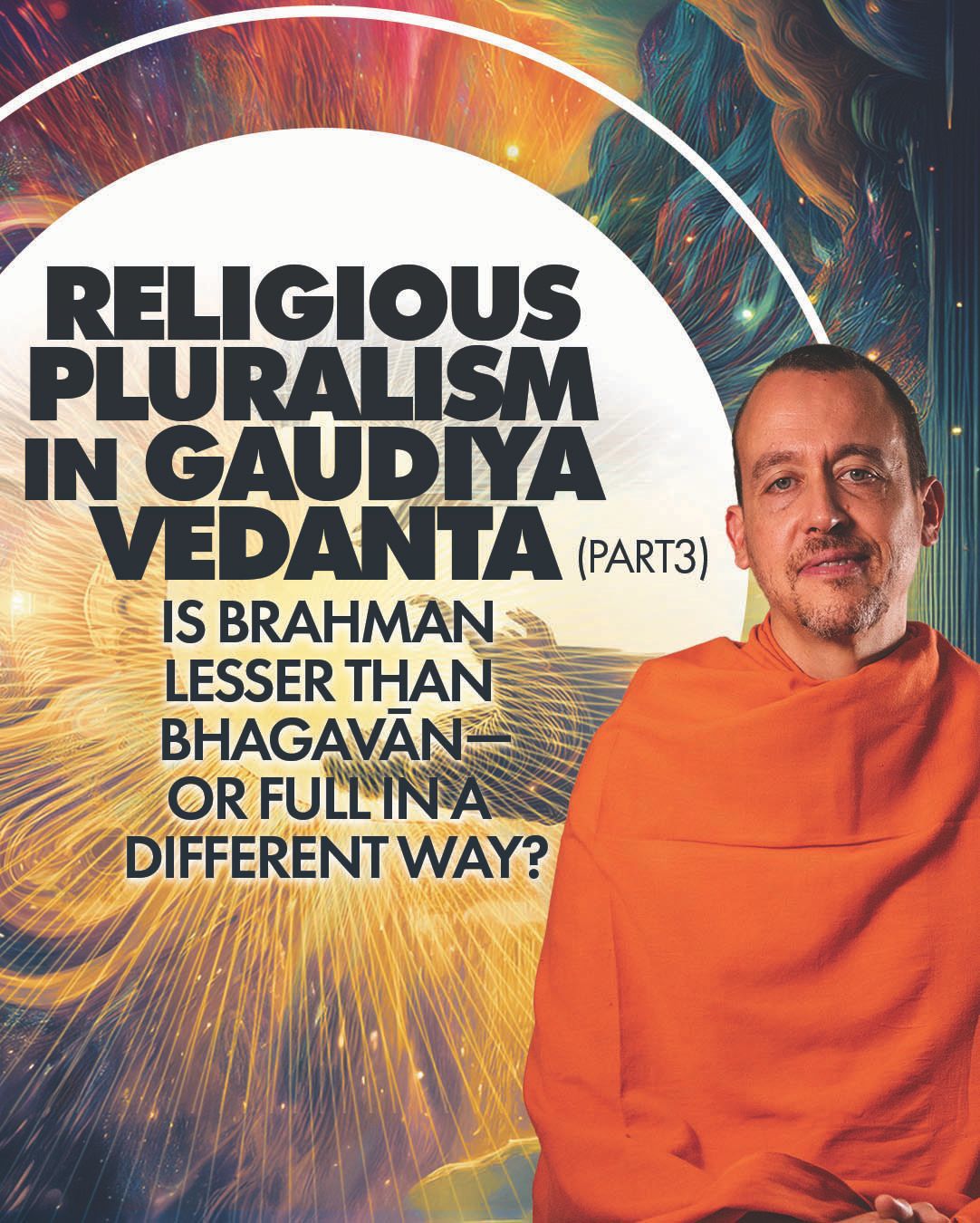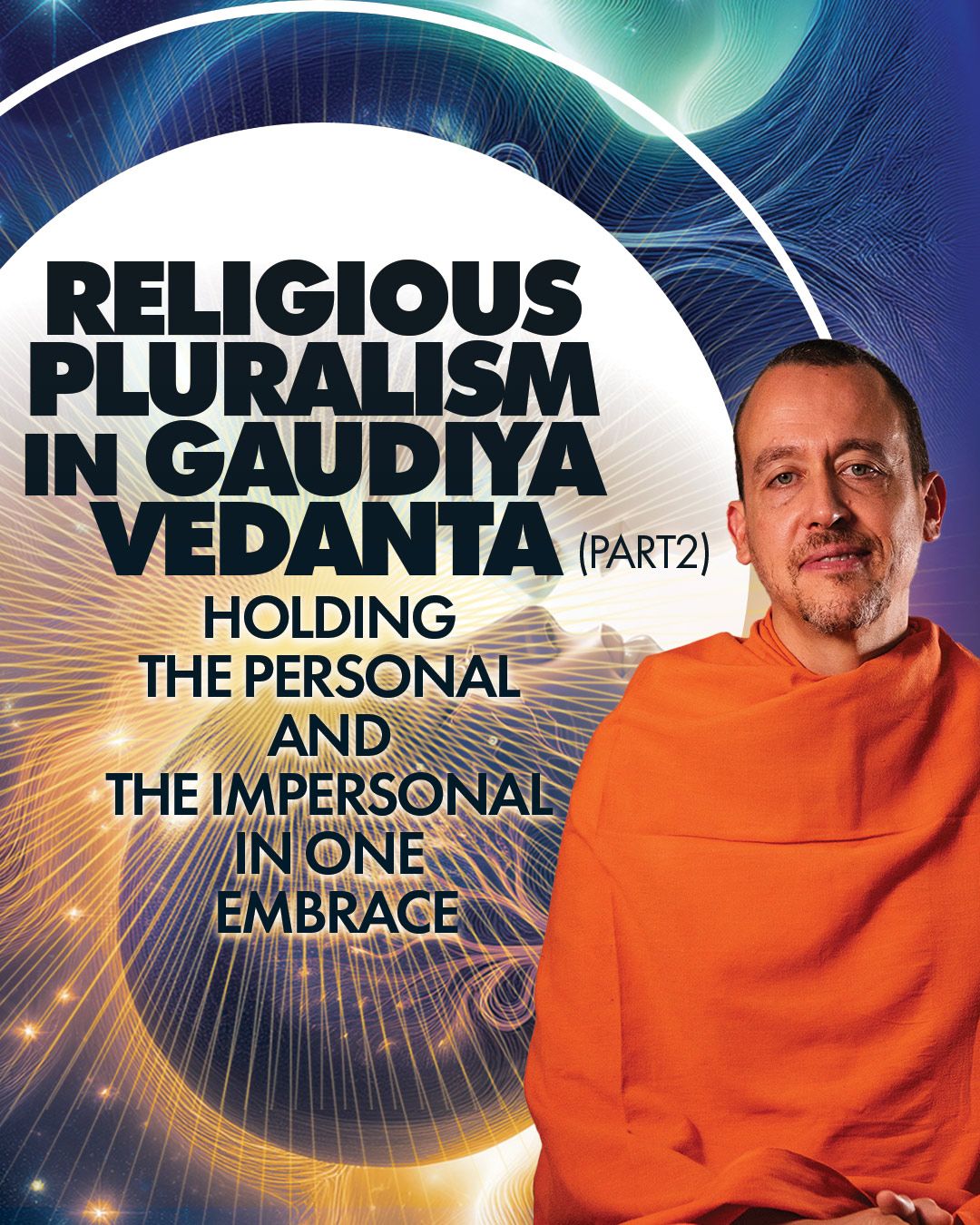I have always been drawn to the principle of unity in diversity. Both before and after officially joining the tradition of Śrī Caitanya, known as Gauḍīya Vaiṣṇavism, I studied—and continue to study—the various insights of not only mystics and saints from multiple schools, but also philosophers, scientists, historians, and poets from both spiritual and secular backgrounds. As a friend recently told me, “It’s gold wherever you find it!”
After being initiated in the Gauḍīya lineage twenty-five years ago, I discovered that there was a word for such a lifestyle—sāragrāhī. This expression, popularized in my tradition by Bhaktivinoda Ṭhākura, refers to an “essence-seeker”: one who is willing to acknowledge and embrace the presence of substance in whatever form it appears. In other words, to be saragrahī is to recognize that truth cannot be monopolized by any single system, but shines through the endless windows of the Infinite. Though I cannot claim any great accomplishment in this arena, I sincerely wish to remain an eternal aspirant to such a vision.
In large part, this is what initially drew me to Gauḍīya Vedānta, the particular Vedāntic approach to reality revealed by Śrī Caitanya. The official name of its metaphysical system is acintya-bhedābheda, which indicates how the nature of reality is paradoxically one and different—the unity in diversity that has captivated me since early in life. Having witnessed extreme forms of exclusivism in most religious traditions, I thought I had finally arrived at my desired, non-sectarian home.
With time, however, I realized that even a deeply inclusive philosophy such as acintya-bhedābheda is often poorly represented—or, more precisely, misrepresented—in ways that once again attempt to present a kind of fundamentalist triumphalism: Gauḍīya Vedānta as “the highest revelation,” “the ultimate conclusion,” “la crème de la crème” of Vedānta. Ironically, what was meant to safeguard plurality was sometimes wielded as a tool for sectarian superiority. This realization set me on a journey of trying to reconcile the many scriptural statements—both from my own tradition and from others—by acknowledging the multiplicity of possibilities when approaching the Infinite.
The Gauḍīya canon itself affirms this principle from the very beginning, in its first written text. Bṛhad-bhāgavatāmṛta (2.4.146) reminds us that “each mood of devotion is dear to God and each gives pleasure to the devotee absorbed in it.” This insight directly echoes Kṛṣṇa’s assurance in the Bhagavad-gītā (4.11), where he declares that “in whatever way someone approaches me, in that very way I reward them.” Similarly, the Caitanya-caritāmṛta (1.5.132) proclaims:
In whatever way someone knows God, in that way they speak of him. All possibilities exist in the Divine—none of them are false.
Taken together, these affirmations highlight a crucial point: Gauḍīya Vedānta does not enforce a single narrative, but rather affirms the validity of multiple approaches to the Divine.
What follows, then, is my attempt not only to show how Gauḍīya Vedānta accepts and becomes nourished by other traditions, but also—after establishing this inclusivity—to specifically concentrate on certain Gauḍīya statements that appear to imply a hierarchy among various expressions of Ultimate Reality, and to explore how these statements may be understood in a genuinely nonsectarian way.
Gauḍīya Vaiṣṇavism constitutes one of many Vaiṣṇava expressions within the wider universe of what most people call “Hinduism,” or, most precisely, Sanātana-dharma. Amidst the spectrum of monism, atheism, pantheism, polytheism, and countless nuances in between, Vaiṣṇavism represents the most popular monotheistic face of Sanātana-dharma. More specifically, it can be described as “polymorphic monotheism”—one God appearing in many forms. This principle is confirmed by a famous verse from the Bhāgavata Purāṇa, where the Absolute is described as bahu-mūrty eka-mūrtikam: “The One has become many forms, yet remains the One.”[1]
Not only does the Divine manifest in “many” forms, but the Bhāgavata also declares these forms to be asaṅkhya—literally “uncountable.”[2] There is no limit to how many forms the Infinite may take in order to reciprocate the love of his devotees.
While I plan to address impersonal notions of the Divine later in this presentation, first I want to focus on how broad and open Gauḍīya Vaiṣṇavism is in its understanding of the personal dimension of the Divine. The very first book written in the Gauḍīya lineage, Sanātana Gosvāmī’s Bṛhad-bhāgavatāmṛta, confirms this with astounding grace.
Its main narrative follows the journey of Gopa-kumāra, a devotee of Kṛṣṇa in the mood of friendship (sakhya-rasa), who on his path toward his ultimate goal meets a vast variety of bhaktas with diverse devotional dispositions. Does Gopa-kumāra dismiss them as inferior to his own cherished mood? Not at all. He deeply appreciates their unique flavors of love and even absorbs impressions (saṁskāras) from their association, which in turn nourishes his own inner devotion.
And while the Bṛhad-bhāgavatāmṛta clearly establishes romantic love (mādhurya-rasa) as the peak of sacred rapture in bhakti, it also highlights the journey of someone like Gopa-kumāra, whose main affinity was for sakhya-bhāva, the intimate friendship of Kṛṣṇa. A lesson here is important, one to which we’ll turn in the next sections: while the tradition honors a hierarchy of rasas, it never invalidates the unique attraction of each individual soul. Whatever flavor of love we are drawn to will be the highest for us. As the Caitanya-caritāmṛta (1.4.43) beautifully expresses:
“Each kind of devotee feels that his sentiment is the most excellent, and thus in that mood he tastes great happiness with Śrī Kṛṣṇa.”
Since the Bṛhad-bhāgavatāmṛta is the first theological text of the Gauḍīya lineage, it sets the tone for what this school of thought represents: a generous, broad, and deep mystical acknowledgement of the infinite variety of ways in which the Sweet Absolute can be approached in devotion.
This openness continued in later works. Rūpa Gosvāmī’s Bhakti-rasāmṛta-sindhu not only draws upon Vallabha’s Vaiṣṇava school by referencing the categories of puṣṭi and maryādā,[3] but also borrows its rasa-theory structure directly from Bharata Muni’s Nāṭya-śāstra. Likewise, Jīva Gosvāmī’s theological magnum opus, the Ṣaṭ-sandarbha, cites other Vaiṣṇava authorities such as Rāmānuja and Madhva as valid sources of evidence. He even quotes Śaṅkara. He does this not merely when he disagrees with some of Śaṅkara’s views, but at times to acknowledge his insight as a genuine contribution to the Vedāntic conversation. This demonstrates that Gauḍīya Vedānta does not live in an echo chamber, but thrives through conversation with the wider spiritual world.
In my book Radical Personalism, I describe this principle as “theological crosspollination.”[4] This is more than mere religious tolerance—where the “other” is reluctantly endured. It is an active exchange in which the gifts of other traditions enrich and fertilize one’s own soil. In crosspollination, one’s vision of the Absolute becomes wider, more fragrant, and more nourishing precisely because it has drawn nectar from beyond the limits of one’s own garden.
Bhaktivinoda Ṭhākura, who himself embodied the spirit of a saragrahī, captures this beautifully:
If one goes to someone else’s place of worship, one should think, ‘These people are worshiping my Lord, but in a different way. Because of my different training, I cannot quite comprehend this system of worship. However, through this experience I can deepen my appreciation for my own system of worship. The Lord is only one, not two. I offer respect to the form I see here and pray to the Lord in this new form that he increases my love for the Lord in his accustomed form.’ Those who do not follow this procedure but instead criticize other systems of worship and show hatred, violence, and envy, are worthless and foolish. The more they indulge in useless quarreling, the more they betray the very goal of their religion.[5]
This statement is extraordinary: Bhaktivinoda Ṭhākura not only advocates respect but insists that encountering another’s worship should deepen one’s own. Far from competition, difference becomes nourishment.
Sometimes what separates us becomes the very surface through which we learn to listen. As Simone Weil puts it, “Two prisoners whose cells adjoin communicate with each other by knocking on the wall. The wall is the thing which separates them but is also their means of communication.”[6] Like neighbors tapping through a common wall, traditions signal across their boundaries—distinct idioms, doctrines, and rites becoming a medium for recognition rather than a barricade. Thus, to appreciate another path is not to deny the line between us, but to lean into it until it carries sound: echoes of the same longing struck in a different key.
Needless to say, this principle extends beyond Hindu schools. If the Absolute truly manifests in countless forms, then Christian devotion to Christ, Islamic surrender to Allah, or Sufi intoxication with the Beloved can be understood as parallel openings into the same One. Gauḍīya Vedānta may have its own preference for the intimacy of Kṛṣṇa-bhakti, but it does not deny the salvific power and dignity of other traditions. Rather, it sees them as further blossoms on the same tree of Divine love, each nourished by the Infinite’s generosity.
This vision resonates with the insight of Frithjof Schuon, who declared that “if God were on the side of one religious form only, the persuasive power of this form would be such that no man of good faith would be able to resist it.”[7] In other words, the very plurality of religious forms testifies to the Infinite’s willingness to be mirrored in countless ways. The multiform beauty of religion is itself a revelation of God’s presence and grace.
In this way, I have tried to briefly show how Gauḍīya Vedānta emphasizes an open-minded approach to the Infinite in devotional terms. It acknowledges the possibility of endless expressions of love, and correspondingly endless self-disclosures of the Absolute in response to that love.
Now, having explored this positive inclusivity, I turn to the main section of this presentation: to consider how the pluralism of Gauḍīya Vedānta interacts with a tradition often seen as its polar opposite—a tradition not rooted in theism but in monism, and often labeled as diametrically opposed to devotional monotheism: Advaita Vedānta.
[1] Bhāgavata Purāṇa 10.40.7.
[2] Bhāgavata Purāṇa 1.3.26.
[3] Rupa Goswami, Bhakti-rasamrita-sindhu 1.2.269 and 1.2.309.
[4] Swami Padmanabha, Radical Personalism, p. 213.
[5] Bhaktivinoda Ṭhākura, Śrī Caitanya-śikṣāmṛta, First Shower.
[6] Simone Weil, Gravity and Grace, p. 145.
[7] Frithjof Schuon, The Transcendent Unity of Religions, p.14.


